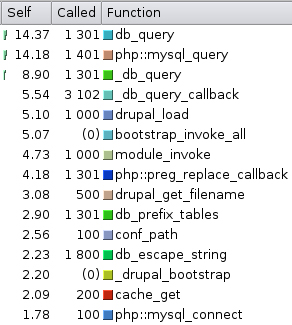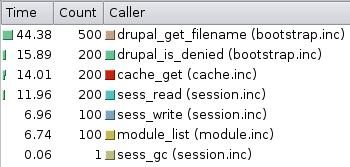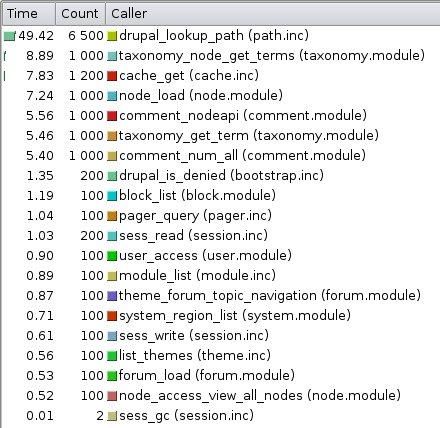Drupal's database interaction
I used XDebug to profile the behavior of Drupal, and to study the interaction with the database server. I aggregated the profile information of 100 requests to the main page using the "Apache, mod_php, PHP4, APC" configuration used for previous benchmark experiments. More information about my experimental setup is available at that page. XDebug generates a trace file with all the profile information which I visualized using KCacheGrind.
Drupal has a page cache mechanism which stores dynamically generated web pages in the database. By caching a web page, Drupal does not have to create the page each time it is requested. Only pages requested by anonymous visitors (users that have not logged on) are cached. Once users have logged on, caching is disabled for them since the pages are personalized in various ways. Because this represents two different modes of operation, I investigated Drupal's behavior with and without page caching.
With page caching

We observe that more than 45% (14.37% + 14.18% + 8.9% + 5.54% + 2.9% + ...) of the execution time is spent in the database related functions. Sending the SQL queries to the database server and waiting for the results takes 14% of the total execution time. Drupal preparing the queries (eg. database prefixing, sanitizing the input to prevent SQL query injection, etc) takes more than 31% of the total execution time. We should look into optimizing the functions that prepare the queries (db_query(), _db_query and _db_query_callback()).
The figure above depicts that PHP's mysql_query() function is called 1401 times. This means that we need 14 SQL queries to serve a cached page. This is where these SQL queries come from:

db_query(). The second column shows how many times each function queried the database and the last column shows the functions' names and source files.Without page caching


db_query(). The second column shows how many times each function queried the database and the last column shows the functions' names and source files.— Dries Buytaert
Dries Buytaert is an Open Source advocate and technology executive. More than 10,000 people are subscribed to his blog. Sign up to have new posts emailed to you or subscribe using RSS. Write to Dries Buytaert at dries@buytaert.net.